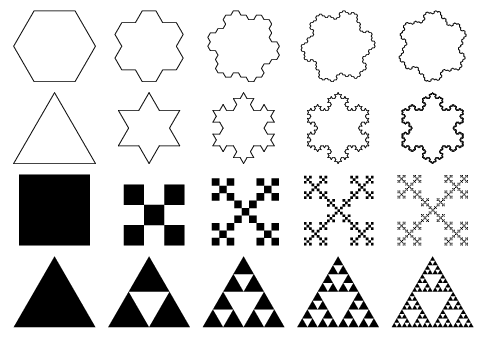 |
| Some fractals getting it on |
The intrinsic problem might be that the timetable of school divides subjects up into categories: the strict division between geography and history is arbitrary, and it is the same physics that operates in the classroom and on the cricket pitch. And the opposition of art and science, rather like the one between religion and science, is based on dogmatic assumptions about the fundamental nature of the objects.
Fortunately, artists aren't so bothered by the division of knowledge. Although Janis Claxton has explained that an understanding of mathematics isn't essential to understand Chaos and Contingency, she acknowledges that numbers are one of the inspirations.
"We are using mathematical structures, games and number patterns as inspiration for creating both material and especially the structure," she says. "I have been inspired by Jon Conway's Game of Life which is a cellular automaton." Conway's Life began as a board game, which needs no players, and explores the mechanism of evolution: through a series of simple rules, it follows the increasing complexity of selection processes. Chaos, designed to be viewed from all sides and above, reflects the patterning that computer versions of Life can reveal.
It isn't so much that it is necessary to understand cellular automaton to appreciate the choreography as that the choreography clarifies some of the ways the automaton operates. The dryness of the computer simulations of Life are replaced with something more visceral, more flowing, more vital.
Claxton adds that fractals were another influence: although these turned up in one of the films at Entre Chien et Loup during the Glasgow Film Festival, they are frequently portrayed as pretty visuals with a psychedelic flavour. Again, the choreography of Chaos illustrates their process, demonstrating how a simple form can be elaborated, by repetition, into something complex and profound.
It's unsurprising that Claxton also mentions Brian Eno: perhaps the most scientific of musicians in terms of process, he not only inspired a generation of electronic musicians but offers strategies for composition. The titular chaos of Claxton's choreography is not so much anarchic disorder but the working out of an idea to a point where it confuses human perception.
 |
| what happens if they keep doing it |
Attempts to shoehorn scientific ideas into dance are not always executed with such precision - even the attempts by Wayne McGregor to get Darwin dancing lost the message within the movement. But by using Life and fractals as a foundation, Claxton moves closer to the application of a scientific method, so that the process becomes a form of experiment while the performance might be analogous to the results.
Although these foundations appear very different to Claxton's best known works, which feed on her academic study of primates, there is a shared enthusiasm for using rigorous research to formulate the movement. Her own eclectic knowledge ensures that every production takes her in a different direction, although she can see the relationship between each piece.
"The week we began this research The New Scientist had a front page and article about Fractals and evolution.We were also working on all the Human Animal stuff so... connections alert!" she remembers.
No comments :
Post a Comment